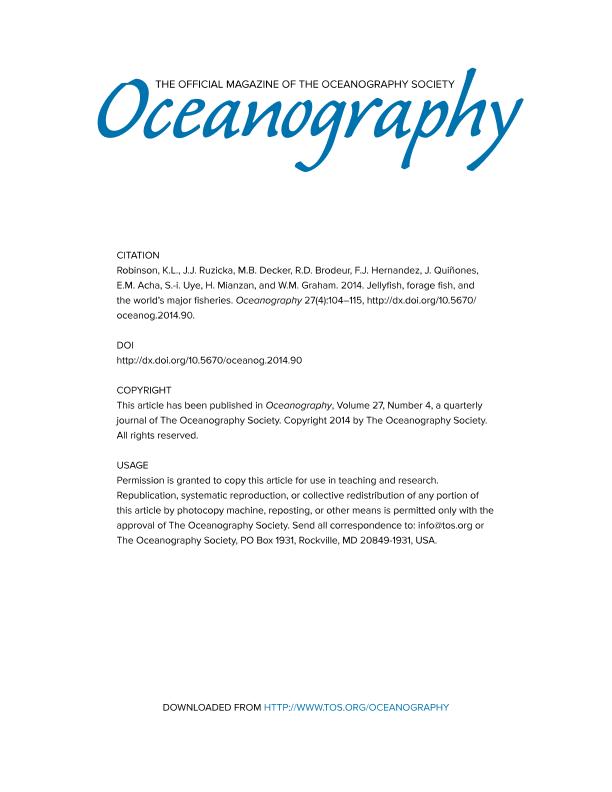Artículo
Jellyfish, Forage Fish, and the World's Major Fisherie
Robinson, Kelly L; Ruzicka, James J.; Decker, Mary Beth; Brodeur, RIchard; Hernandez, Frank; Quiñones Dávila, Javier; Acha, Eduardo Marcelo ; Uye, Shin-ichi; Mianzan, Hermes Walter
; Uye, Shin-ichi; Mianzan, Hermes Walter ; Graham, William M.
; Graham, William M.
 ; Uye, Shin-ichi; Mianzan, Hermes Walter
; Uye, Shin-ichi; Mianzan, Hermes Walter ; Graham, William M.
; Graham, William M.
Fecha de publicación:
12/2014
Editorial:
Oceanography Society
Revista:
Oceanography
ISSN:
1042-8275
Idioma:
Inglés
Tipo de recurso:
Artículo publicado
Clasificación temática:
Resumen
A majority of the world’s largest net-based fisheries target planktivorous forage fish that serve as a critical trophic link between the plankton and upper-level consumers such as large predatory fishes, seabirds, and marine mammals. Because the plankton production that drives forage fish also drives jellyfish production, these taxa often overlap in space, time, and diet in coastal ecosystems. This overlap likely leads to predatory and competitive interactions, as jellyfish are effective predators of fish early life stages and zooplankton. The trophic interplay between these groups is made more complex by the harvest of forage fish, which presumably releases jellyfish from competition and is hypothesized to lead to an increase in their production. To understand the role forage fish and jellyfish play as alternate energy transfer pathways in coastal ecosystems, we explore how functional group productivity is altered in three oceanographically distinct ecosystems when jellyfish are abundant and when fish harvest rates are reduced using ecosystem modeling. We propose that ecosystem-based fishery management approaches to forage fish stocks include the use of jellyfish as an independent, empirical “ecosystem health” indicator.
Palabras clave:
Medusae
,
Forage Fish
,
Interactions
,
Fisheries
Archivos asociados
Licencia
Identificadores
Colecciones
Articulos(CCT - MAR DEL PLATA)
Articulos de CTRO.CIENTIFICO TECNOL.CONICET - MAR DEL PLATA
Articulos de CTRO.CIENTIFICO TECNOL.CONICET - MAR DEL PLATA
Articulos(IIMYC)
Articulos de INSTITUTO DE INVESTIGACIONES MARINAS Y COSTERAS
Articulos de INSTITUTO DE INVESTIGACIONES MARINAS Y COSTERAS
Citación
Robinson, Kelly L; Ruzicka, James J.; Decker, Mary Beth; Brodeur, RIchard; Hernandez, Frank; et al.; Jellyfish, Forage Fish, and the World's Major Fisherie; Oceanography Society; Oceanography; 27; 4; 12-2014; 104-115
Compartir
Altmétricas



